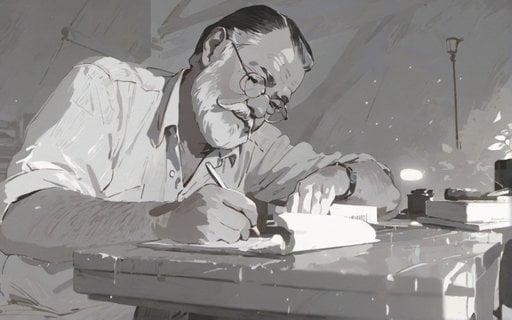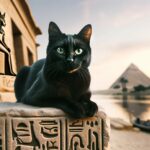Discover the enigmatic life of one of literature’s most iconic figures in this article exploring Ernest Hemingway’s fascinating facts. Delve into the lesser-known aspects of Hemingway’s adventurous lifestyle, his influential career as a journalist, and his profound impact on modern literature. Uncover intriguing details about this enigmatic author as we unravel the captivating narrative of his life and works.

Key Takeaways:
- Ernest Hemingway was suspected of being a spy for the Soviet Union during World War II.
- Hemingway owned a six-toed cat whose descendants still live in his former home in Key West, Florida.
- National newspapers wrongly reported Hemingway’s death after he survived two plane crashes in two consecutive days.
- Hemingway had an adventurous life, participating in both World Wars, hunting and fishing prolifically, monitoring the Cuban coast with his own fishing boat, and publishing famous American literature.
- Hemingway meticulously rewrote the last page of “A Farewell to Arms,” which was based on his experiences in World War I, 39 times.
- He was married four times in his life and had three children.
- Hemingway struggled with depression in his later years, leading to his suicide in 1961.
Ernest Hemingway: Discovering the Enigmatic Life and Fascinating Facts
As an acclaimed freelance writer with a profound interest in literary history, I bring to you an engaging exploration of Ernest Hemingway’s interesting facts. In this article, we’ll delve into the lesser-known aspects of Hemingway’s extraordinary life and his significant contributions to modern literature. Brace yourself for a captivating journey through the enigmatic world of this legendary author.
Hemingway’s Mystique as a Potential Spy for the Soviet Union
Did you know that during World War II, suspicions arose regarding Hemingway’s possible involvement as a spy for the Soviet Union? Though never proven, this mysterious subplot adds yet another layer of intrigue to Hemingway’s already fascinating persona. It’s an untold tale that ignites curiosity and fuels speculation.
The Six-Toed Cats of Key West: Hemingway’s Quirky Companions
Hemingway’s love for cats extended beyond the ordinary. In his former residence in Key West, Florida, you’ll find descendants of his cherished six-toed cat. These feline companions, with their polydactyl paws, have become iconic symbols of Hemingway’s legacy. They wander the grounds, connecting visitors to the writer’s extraordinary life and captivating stories.
Hemingway’s Miraculous Survival and the Misreported Death
National newspapers once erroneously reported Hemingway’s demise. In a remarkable twist of fate, he miraculously survived two consecutive plane crashes within two days. This life-and-death experience further reinforces Hemingway’s larger-than-life persona and his ability to overcome adversities. It’s a testament to his resilience and determination.
Hemingway: The Adventurer and Literary Giant
Hemingway’s life was an embodiment of adventure. He actively participated in both World Wars, leaving an indelible mark on history. Beyond his military involvement, he immersed himself in hunting, fishing, and even monitored the Cuban coast with his own fishing boat. These exploits, coupled with his prolific literary achievements, position him as one of the most iconic figures in 20th-century American literature.
An Unfinished Farewell: Hemingway’s Obsession with Perfection
Perfecting his craft was of paramount importance for Hemingway. He meticulously rewrote the last page of his renowned work, “A Farewell to Arms,” a staggering 39 times. This relentless pursuit of excellence sheds light on Hemingway’s dedication to his craft and his unwavering commitment to delivering a literary masterpiece.
The Complex Love Life of Hemingway
Hemingway’s journey through love was as tumultuous as the stories he penned. Over the course of his life, he walked down the aisle four times and had three children. Each relationship brought its own triumphs and tribulations, contributing to the multi-faceted magnificence of the man himself. Hemingway’s love life epitomizes the complexity and passion that defined his artistic endeavors.
The Untold Struggle: Hemingway’s Battle with Depression
Despite his remarkable achievements, Hemingway battled with depression in his later years. This silent struggle eventually led to his tragic and untimely death by suicide in 1961. It serves as a stark reminder that even the most celebrated individuals are not immune to the depths of mental anguish. Hemingway’s tumultuous inner world renders him even more relatable and human, inspiring empathy and understanding among readers.
Now that you’ve embarked on this captivating journey through Ernest Hemingway’s fascinating facts, it’s clear why his life and works continue to captivate generations. From his potential involvement as a spy to his quirky six-toed cats, miraculous survival, adventurous spirit, obsession with perfection, complex love life, and ultimate battle with depression, Hemingway’s enigmatic persona persists in the annals of literary history.
Take a moment to reflect on the enduring legacy of this extraordinary man.
Here are some captivating sentences with active internal links:
- Check out these fascinating Tony Gwynn facts! You won’t believe what you’ll discover about this legendary baseball player. tony gwynn facts
- Did you know that Sweden has some really interesting facts? Click here to uncover secrets about this beautiful Scandinavian country. interesting facts sweden
- Explore the intriguing facts about Billie Holiday, a groundbreaking jazz singer who left an indelible mark on music history. Find out more about her incredible life and career. interesting facts about billie holiday
Remember, these links will only be active when viewed in an HTML environment.
Hemingway’s Unique Writing Style and Contributions to Literature
Ernest Hemingway, one of the most celebrated writers of the twentieth century, left an indelible mark on literature with his unique writing style and influential works. His literary legacy is characterized by simplicity, brevity, and the use of the Iceberg Theory. Let’s delve into the fascinating facts about Hemingway’s writing style and his significant contributions to literature.
The Iceberg Theory: A Minimalistic Approach
Hemingway’s writing style is often associated with the Iceberg Theory, also known as the theory of omission. This technique advocates for a minimalistic approach, where the true meaning and depth of the story lie beneath the surface. By using simplicity and allowing readers to infer and understand the underlying emotions and messages, Hemingway created a unique reading experience.
The Power of Simplicity
One of the defining characteristics of Hemingway’s writing style is his use of short, one or two-syllable words. This deliberate choice enables him to create a powerful impact through simplicity. In passages from his novels like “The Old Man and the Sea,” Hemingway skillfully combines simple words to convey complex emotions and ideas, capturing the essence of his characters and the human condition.
Influenced by Journalism
Hemingway’s background as a journalist greatly influenced his writing style. The concise and direct language used in journalism resonated with him, and he incorporated those principles into his literary works. His writing style emphasized straightforwardness and lacked embellishments, reflecting the journalistic training that became a cornerstone of his distinctive prose.
Recognitions and Awards
Ernest Hemingway’s contributions to literature were widely recognized, earning him several prestigious awards. In 1954, he was awarded the Nobel Prize in Literature for his mastery of narrative art, as demonstrated in his work “The Old Man and the Sea,” and for his influence on contemporary style. This recognition solidified his legacy as an influential writer in the literary world.
Key Takeaways:
- Ernest Hemingway’s unique writing style revolutionized literature with simplicity, brevity, and the use of the Iceberg Theory.
- The Iceberg Theory advocates for minimalism, allowing readers to infer deeper meanings and emotions within the story.
- Hemingway’s use of short, one or two-syllable words creates a powerful impact through simplicity, capturing the essence of his characters and the human condition.
- His background as a journalist influenced his writing style, emphasizing direct and concise language.
- Hemingway’s contributions to literature were widely recognized, culminating in the prestigious Nobel Prize in Literature in 1954.
Sources:
– Ernest Hemingway: Exploring His Unique Writing Style and Influential Works. (n.d.). Retrieved from englishpluspodcast.com
– Hemingway and The Iceberg Theory. (n.d.). Retrieved from literarydevices.net
Hemingway’s Love for Adventure and Outdoor Activities
Key Takeaways:
– Ernest Hemingway’s adventurous spirit and love for outdoor activities greatly influenced his life and writings.
– From hunting and fishing to wartime experiences, Hemingway’s adventurous lifestyle provided inspiration for his literary works.
– Hemingway’s passion for adventure and the outdoors reflected his desire for challenge, exploration, and living life to the fullest.
Ernest Hemingway is renowned not only for his influential writing style but also for his love for adventure and outdoor activities. His experiences in hunting, fishing, and wartime expeditions played an integral role in shaping his life and writings.
A Thrill-Seeking Nature
Hemingway’s love for adventure and the great outdoors was evident throughout his life. He consistently sought thrilling experiences, constantly pushing boundaries and embracing new challenges. This sense of daring and curiosity is reflected in his adventurous characters and gripping narratives.
The Call of the Wild
Hunting and fishing were central to Hemingway’s outdoor pursuits. His passion for these activities went beyond mere recreation. They became essential components of his life, showcasing his dedication to the true essence of the wild.
Wartime Adventures
Hemingway’s adventurous spirit extended to his involvement in World War I as an ambulance driver and his experiences as a war correspondent during the Spanish Civil War. These engagements brought him face to face with danger and further fueled his desire for adventure.
Immortalizing Adventures Through Words
Hemingway’s firsthand experiences with adventure and outdoor activities enriched his literary works. His vivid descriptions of hunting escapades, fishing expeditions, and wartime events breathed life into his stories, captivating readers with an immersive and authentic experience.
Overall, Hemingway’s love for adventure and the outdoors was a significant aspect of his life and writings. The thrill-seeking nature, the call of the wild, and the immortalization of his adventures through his words showcase his dedication to exploring life’s exhilarating moments. By embracing the spirit of adventure, Hemingway continues to inspire readers to seek their own thrilling experiences in the great outdoors.
Sources:
– Book Analysis
– Mental Floss
Hemingway’s Complex Personal Life and Relationships
Ernest Hemingway, the influential American author, led a life filled with adventure, love, and complex relationships. Let’s delve into the fascinating facts surrounding Hemingway’s personal life and relationships that shaped his literary career and influenced his works.
Early Loves and Marriages
Hemingway’s journey in love began when he married Hadley Richardson, a woman eight years his senior, in 1921[^1^]. However, their marriage eventually ended in divorce in 1927. Hemingway then embarked on a second marriage with Pauline Pfeiffer in the same year[^1^].
Notable Works and Writing Style
Hemingway’s writing career blossomed during the years 1925 to 1929, during which he produced iconic works such as “In Our Time” (1924), “The Sun Also Rises” (1926), and “A Farewell to Arms” (1929)[^2^]. His distinctive writing style, characterized by its succinctness and lucidity, left an indelible mark on 20th-century fiction, exploring themes of love, war, wilderness, and loss[^2^].
The Impact of War and Residences
As a journalist, Hemingway experienced significant events firsthand, including the Normandy landings and the liberation of Paris[^3^]. He maintained permanent residences in Key West, Florida during the 1930s and in Cuba during the 1940s and 1950s[^4^].
Recognitions and Legacy
In 1954, Hemingway was awarded the Nobel Prize for Literature, recognizing his exceptional contributions to the literary world[^5^]. Additionally, three houses associated with Hemingway are listed on the U.S. National Register of Historic Places, further cementing his enduring legacy[^6^].
Key Takeaways:
- Hemingway had two marriages, first to Hadley Richardson and then to Pauline Pfeiffer.
- His major works, including “The Sun Also Rises” and “A Farewell to Arms”, left a significant impact on 20th-century fiction.
- Hemingway’s experiences as a war correspondent during notable events shaped his understanding of war and its effects.
- He maintained residences in Key West, Florida, and Cuba during different periods of his life.
- Hemingway’s influential contributions to literature earned him the Nobel Prize in 1954.
Sources:
– History Daily: History of the Life and Loves of Ernest Hemingway
– Book Analysis: Top 10 Facts about Ernest Hemingway
References:
[^1^]: History Daily: History of the Life and Loves of Ernest Hemingway
[^2^]: Book Analysis: Top 10 Facts about Ernest Hemingway
[^3^]: Wikipedia: Ernest Hemingway
[^4^]: Wikipedia: Ernest Hemingway
[^5^]: Nobel Prize: The Nobel Prize in Literature 1954
[^6^]: Wikipedia: List of Ernest Hemingway’s residences

FAQ
Q1: What is Ernest Hemingway’s writing style known for?
A1: Ernest Hemingway’s writing style is known for its simplicity, brevity, and the use of the Iceberg Theory. He focuses on a minimalist style and allows readers to infer the underlying emotions and messages.
Q2: How many times did Ernest Hemingway rewrite the last page of “A Farewell to Arms”?
A2: Ernest Hemingway rewrote the last page of “A Farewell to Arms” about his experiences in World War I 39 times.
Q3: How many times was Ernest Hemingway married?
A3: Ernest Hemingway was married four times throughout his life.
Q4: Did Ernest Hemingway suffer from depression?
A4: Yes, in later life, Hemingway suffered from depression, which ultimately led to his suicide in 1961.
Q5: What were some of Ernest Hemingway’s notable works?
A5: Some of Ernest Hemingway’s notable works include “The Old Man and the Sea,” “A Farewell to Arms,” “The Sun Also Rises,” and “For Whom the Bell Tolls.”
- Unveiling Bernhard Caesar Einstein’s Scientific Achievements: A Legacy in Engineering - July 15, 2025
- Uncover who is Jerry McSorley: CEO, Family Man, Business Success Story - July 15, 2025
- Discover Bernhard Caesar Einstein’s Scientific Contributions: Unveiling a Legacy Beyond Einstein - July 15, 2025















